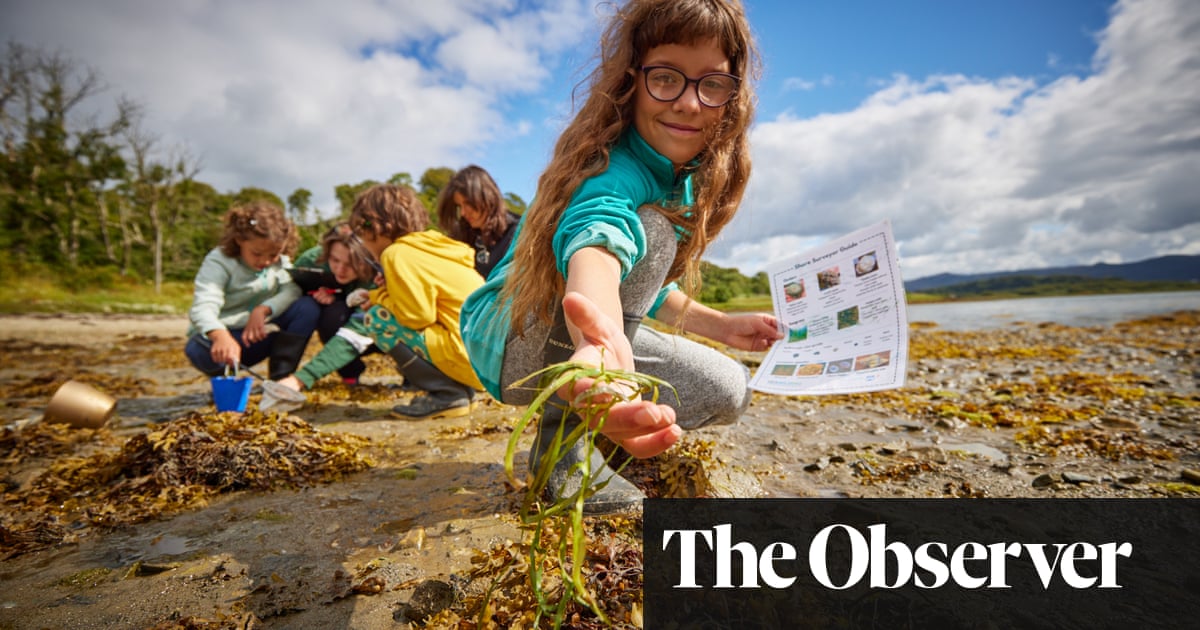Boosting Scotland's Coastline: Seagrass Planting Initiatives

Table of Contents
The Ecological Importance of Seagrass in Scotland's Coastal Waters
Seagrass meadows are often referred to as the "lungs of the ocean," and for good reason. Their impact on Scotland's coastal waters is profound and multifaceted.
Biodiversity Hotspots
Seagrass beds act as bustling underwater cities, providing vital nurseries and habitats for a vast array of marine life. They offer shelter from predators, feeding grounds, and breeding areas. This biodiversity supports the entire coastal ecosystem.
- Key Species: Numerous commercially important fish species, such as cod, haddock, and plaice, rely on seagrass for part or all of their life cycle. Invertebrates like prawns, crabs, and various shellfish also thrive in these meadows, forming the base of the food web. Seabirds, including ducks and wading birds, also depend on the rich invertebrate life within seagrass beds.
- Biodiversity Statistics: Studies have shown that a single hectare of seagrass can support over 100 different species of plants and animals, underlining its immense ecological value. This biodiversity contributes to the overall health and resilience of Scotland's coastal waters.
Carbon Sequestration and Climate Change Mitigation
Seagrass meadows are remarkably effective at absorbing and storing atmospheric carbon dioxide, a greenhouse gas responsible for climate change. This "blue carbon" sequestration plays a crucial role in climate change mitigation.
- Carbon Sequestration Capacity: Seagrass can sequester carbon at a rate several times higher than terrestrial forests, making it a powerful ally in the fight against climate change. Ongoing research in Scotland is quantifying the precise carbon capture potential of its seagrass meadows.
- Blue Carbon and Scotland's Climate Goals: Recognizing the significance of blue carbon, Scotland is increasingly integrating seagrass restoration into its broader climate change mitigation strategies. Protecting and restoring these ecosystems are key to achieving the country's ambitious environmental targets.
Coastal Protection and Erosion Control
Seagrass meadows provide invaluable coastal protection by reducing wave energy and stabilizing sediments. This natural buffering effect helps protect coastlines from erosion and storm damage.
- Examples in Scotland: Numerous coastal areas in Scotland, particularly in sheltered bays and estuaries, benefit from the protective effect of seagrass. These areas experience less erosion and are more resilient to storm surges thanks to the presence of healthy seagrass meadows.
- Economic Benefits: The economic benefits of reduced coastal erosion are substantial, saving millions in coastal defenses and protecting valuable properties and infrastructure. Investing in seagrass restoration is therefore a cost-effective strategy for long-term coastal protection.
Existing and Planned Seagrass Planting Initiatives in Scotland
Several organizations are actively engaged in restoring Scotland's seagrass meadows, employing various innovative techniques.
Ongoing Projects
Scotland is witnessing a surge in seagrass restoration projects. These efforts demonstrate a growing commitment to marine conservation and highlight the possibilities of large-scale restoration.
- Specific Projects: Several organizations, including government agencies like NatureScot, charities such as the Marine Conservation Society, and universities such as the University of St Andrews, are actively involved in seagrass restoration projects across Scotland. Specific project locations and methodologies vary, employing techniques like seed dispersal and transplantation. (Links to relevant websites would be included here).
- Methodologies: Planting techniques range from the dispersal of seagrass seeds to the transplantation of seagrass shoots. Careful site selection and ongoing monitoring are crucial to the success of these initiatives.
Future Plans and Expansion
Future plans aim to significantly expand seagrass planting across Scotland's coastline, potentially incorporating citizen science initiatives and fostering greater community involvement.
- Potential Areas: Numerous areas along the Scottish coastline have been identified as suitable for seagrass restoration, offering the potential to significantly enhance Scotland's blue carbon resources.
- Challenges and Opportunities: Challenges include securing sufficient funding, overcoming environmental threats (pollution, climate change, invasive species), and addressing the complexities of seagrass ecology. However, the potential benefits are significant, prompting ambitious plans for future expansion and innovation.
Challenges and Opportunities in Seagrass Restoration
While Scotland is making strides in seagrass restoration, several challenges remain, requiring innovative solutions and collaborative efforts.
Environmental Challenges
Seagrass meadows face numerous threats, demanding a multifaceted approach to restoration.
- Key Threats: Pollution from agricultural runoff, untreated sewage, and industrial discharges are major threats. Climate change, manifested in rising sea temperatures and ocean acidification, also impacts seagrass health. Invasive species can outcompete native seagrass, hindering restoration efforts.
- Impact on Restoration: These threats can negatively impact the survival and growth of planted seagrass, making restoration efforts more challenging. Addressing these issues is critical to achieving long-term success.
Technological Advancements
Technological advancements are playing an increasing role in enhancing the efficiency and effectiveness of seagrass restoration.
- Innovative Technologies: Drones equipped with high-resolution cameras are used for mapping seagrass meadows and monitoring their growth. Underwater sensors provide real-time data on water quality and seagrass health. These tools greatly enhance monitoring and management efforts.
- Enhancing Efficiency: These technologies help optimize planting strategies, identify suitable planting sites, and track the progress of restoration initiatives, leading to improved outcomes.
Funding and Collaboration
Securing adequate funding and fostering collaboration among various stakeholders are essential for the long-term success of seagrass restoration.
- Improving Funding and Collaboration: Increased government investment, philanthropic support, and private sector involvement are crucial. Strengthening collaborations between researchers, government agencies, conservation organizations, and local communities is also essential for effective restoration.
- Multifaceted Approach: A coordinated, multi-faceted approach that integrates scientific knowledge, community engagement, and policy support is vital to achieving ambitious seagrass restoration goals in Scotland.
Conclusion
Seagrass planting initiatives offer immense ecological, economic, and climate-related benefits to Scotland's coastline. These underwater meadows support biodiversity, sequester significant amounts of carbon, and provide crucial coastal protection. The ongoing and planned projects in Scotland demonstrate a growing commitment to restoring these vital ecosystems. However, challenges remain, necessitating a collaborative, innovative, and well-funded approach.
To safeguard Scotland's stunning coastline and contribute to a healthier planet, we must actively support and participate in seagrass planting initiatives. Learn more about seagrass and the organizations involved in restoration efforts, and consider volunteering your time or donating to support this crucial work. By working together, we can restore Scotland's seagrass meadows and ensure a thriving marine environment for generations to come through continued seagrass planting and conservation.

Featured Posts
-
 Transportation Department To Reduce Staff At End Of May
May 05, 2025
Transportation Department To Reduce Staff At End Of May
May 05, 2025 -
 Final Destinations Scariest Death Scene Is Back A 22 Year Wait Ends
May 05, 2025
Final Destinations Scariest Death Scene Is Back A 22 Year Wait Ends
May 05, 2025 -
 Tournage De L Age D Or Premier Long Metrage De Berenger Thouin
May 05, 2025
Tournage De L Age D Or Premier Long Metrage De Berenger Thouin
May 05, 2025 -
 Katie Nolans Statement On Recent Allegations By Charlie Dixon
May 05, 2025
Katie Nolans Statement On Recent Allegations By Charlie Dixon
May 05, 2025 -
 Bianca Censoris Provocative Bra And Thong Look While Roller Skating
May 05, 2025
Bianca Censoris Provocative Bra And Thong Look While Roller Skating
May 05, 2025
Latest Posts
-
 Kentucky Derby 2025 Getting To Know The Riders
May 05, 2025
Kentucky Derby 2025 Getting To Know The Riders
May 05, 2025 -
 Max Verstappen New Parent Miami Gp On The Horizon
May 05, 2025
Max Verstappen New Parent Miami Gp On The Horizon
May 05, 2025 -
 2025 Kentucky Derby A Look At The Competing Jockeys
May 05, 2025
2025 Kentucky Derby A Look At The Competing Jockeys
May 05, 2025 -
 Max Verstappens Paternity And The Miami Grand Prix
May 05, 2025
Max Verstappens Paternity And The Miami Grand Prix
May 05, 2025 -
 Meet The Jockeys Your 2025 Kentucky Derby Preview
May 05, 2025
Meet The Jockeys Your 2025 Kentucky Derby Preview
May 05, 2025
